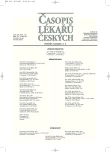Incidence, Diagnostics and Therapy of the Lung Cancer in the Czech Republic in 2003
Authors:
M. Marel; F. Krejbich; P. Stránská; Z. Skácel; O. Měřička; J. Homolka
Authors‘ workplace:
I. klinika tuberkulózy a respiračních nemocí 1. LF UK a VFN, Praha
Published in:
Čas. Lék. čes. 2007; 146: 474-478
Category:
Original Article
Overview
Lung cancer epidemic has not ended. According to the data on the incidence and mortality in the Czech Republic it is obvious that both parameters decline in males; the rise in women probably ends. According to the present epidemiological parameters the number of new cases is still very high. Number of adenocarcinomas is slightly rising. No improvement has been achieved in the early diagnostics of TNM stage I and II, which are diagnosed in less than 21 %. It brings low number of indications for resection therapy, which in 2003 achieved 10.8 % for men and 10.1 % for women. Positive appears the higher number of verified tumours (72 % in men and 69 % in women) and the higher percentage of those who survived over 5 years (6.3 % in men and 9.4 % in women) in comparison with the situation 10 years earlier. The presented paper describes regional differences in the incidence of lung carcinoma (apparent gradient between the western and eastern part of the country) and the promptness of the diagnostics and the treatment indications.
Key words:
lung cancer, adenocarcinoma, non-resection therapy.
Labels
Addictology Allergology and clinical immunology Angiology Audiology Clinical biochemistry Dermatology & STDs Paediatric gastroenterology Paediatric surgery Paediatric cardiology Paediatric neurology Paediatric ENT Paediatric psychiatry Paediatric rheumatology Diabetology Pharmacy Vascular surgery Pain management Dental HygienistArticle was published in
Journal of Czech Physicians

Most read in this issue
- Bioequivalence Studies of Pharmaceutical Preparations
- Study of the Eosinophilic Inflammation Activity in Bronchial Asthma
- Stress Cardiomyopathy
- Is Prescription of Physical Activity a Part of Health Care in Civilization Disorders? Results of Questionnaire Study in Medical Doctors
